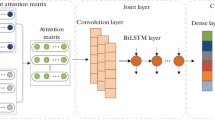Abstract
Adverse drug reactions (ADR) include adverse reactions which are caused by drug quality problems or improper medication. In order to solve the issues which are triggered by the lack of research on local adverse drug reactions in Xinjiang and the shortcomings of traditional models in dealing with irregular sentences, this paper proposes a method for adverse drug identification in Xinjiang. The method is combined with BiLSTM-CNN hybrid network which is based on attention mechanism. The method analyzes deeply on the network text context feature and the attention pooling mechanism. These measures can reduce the information loss while acquiring the local convolution feature. The integration of attention mechanism, the addition of weight information make it becomes more sensitive to capture the importance of features which brings improvement of the ability to express features. Finally, the experiment was carried out in the Xinjiang Adverse Drug Reaction Data Set. The accuracy rate of this model in Xinjiang local drug adverse reaction identification was 87.27%, the recall rate was 88.87%, and the F value was 87.65%. Compared with the common convolutional neural network and BiLSTM, it achieves better classification results, and has obvious advantages for irregular grammar and long sentence recognition. Experiments showed that the ATT-BiLSTM-CNN model can rapidly improve the recognition performance of local adverse drug reactions in Xinjiang.






Similar content being viewed by others
REFERENCES
Friedrich, S. and Dalianis, H., Adverse drug event classification of health records using dictionary based pre-processing and machine learning, Proceedings of the Sixth International Workshop on Health Text Mining and Information Analysis, 2015, pp. 121–130.
Huynh, T., He, Y., Willis, A., and Rüger, S., Adverse drug reaction classification with deep neural networks, Proceedings of COLING 2016, the 26th International Conference on Computational Linguistics: Technical Papers, 2016, pp. 877–887.
Aroyehun, S.T. and Gelbukh, A., Automatic identification of drugs and adverse drug reaction related tweets, Proceedings of the 2018 EMNLP Workshop SMM4H: The 3rd Social Media Mining for Health Applications Workshop and Shared Task, 2018, pp. 54–55.
Segura-Bedmar, I., Revert, R., and Martínez, P., Detecting drugs and adverse events from Spanish social media streams, Proceedings of the 5th International Workshop on Health Text Mining and Information Analysis (LOUHI), 2014, pp. 106–115.
Leaman, R., Wojtulewicz, L., Sullivan, R., Skariah, A., Yang, J., and Gonzalez, G., Towards internet-age pharmacovigilance: Extracting adverse drug reactions from user posts to health-related social networks, Proceedings of the 2010 Workshop on Biomedical Natural Language Processing, 2010, pp. 117–125.
Sager, N., Lyman, M., Bucknall, C., Nhan, N., and Tick, L.J. Natural language processing and the representation of clinical data, J. Am. Med. Inf. Assoc., 1994, vol. 1, no. 2, pp. 142–160.
Tang, D., Qin, B., and Liu, T., Aspect level sentiment classification with deep memory network, arXiv preprint arXiv:1605.08900, 2016.
Chen, Q., Zhu, X., Ling, Z., Wei, S., Jiang, H., and Inkpen, D., Enhanced LSTM for natural language inference, arXiv preprint arXiv:1609.06038, 2016.
Chua, L.O. and Roska, T., The CNN paradigm, IEEE Trans. Circuits Syst. I: Fundam. Theory Appl., 1993, vol. 40, no. 3, pp. 147–156.
Hochreiter, S. and Schmidhuber, J., Long short-term memory, Neural Comput., 1997, vol. 9, no. 8, pp. 1735–1780.
Mikolov, T., Kopecky, J., Burget, L., and Glembek, O., Neural network based language models for highly inflective languages, 2009 IEEE International Conference on Acoustics, Speech and Signal Processing, 2009, pp. 4725–4728.
Hinton, G.E., McClelland, J.L., and Rumelhart, D.E., Distributed Representations, Pittsburgh, PA: Carnegie-Mellon University, 1984, pp. 1–127.
Camacho-Collados, J. and Pilehvar, M.T., On the role of text preprocessing in neural network architectures: An evaluation study on text categorization and sentiment analysis, arXiv preprint arXiv:1707.01780, 2017.
Sun, J., 'Jieba' Chinese word segmentation tool, 2012. https://github.com/fxsjy/jieba.
Er, M.J., Zhang, Y., Wang, N., and Pratama, M., Attention pooling-based convolutional neural network for sentence modeling, Inf. Sci., 2016, vol. 373, pp. 388–403.
Hochreiter, S. and Schmidhuber, J., Long short-term memory, Neural Comput., 1997, vol. 9, no. 8, pp. 1735–1780.
Mikolov, T., Sutskever, I., Chen, K., Corrado, G.S., and Dean, J., Distributed representations of words and phrases and their compositionality, in Advances in Neural Information Processing Systems, 2013, pp. 3111–3119.
Mnih, V., Heess, N., and Graves, A., Recurrent models of visual attention, in Advances in Neural Information Processing Systems, 2014, pp. 2204–2212.
Graves, A., Jaitly, N., and Mohamed, A.R., Hybrid speech recognition with deep bidirectional LSTM, 2013 IEEE Workshop on Automatic Speech Recognition and Understanding, 2013, pp. 273–278.
Lilleberg, J., Zhu, Y., and Zhang, Y., Support vector machines and word2vec for text classification with semantic features, 2015 IEEE 14th International Conference on Cognitive Informatics and Cognitive Computing (ICCI CC), 2015, pp. 136–140.
Kim, Y., Convolutional neural networks for sentence classification, arXiv preprint arXiv:1408.5882, 2014.
Funding
This research is partially supported by The National Natural Science Foundation of China (nos. 61 563 051, 61 662 074, 61 262 064). The Key Project of National Natural Science Foundation of China (61 331 011). Xinjiang Uygur Autonomous Region Scientific and Technological Personnel Training Project (QN2016YX0051). Xinjiang Tianshan Youth Project (2017Q011).
Author information
Authors and Affiliations
Corresponding authors
Ethics declarations
The authors declare that they have no conflicts of interest.
About this article
Cite this article
Xiaozhuo Wang, Tian, S., Yu, L. et al. Identification of Local Adverse Drug Reactions in Xinjiang Based on Attention Mechanism and BiLSTM-CNN Hybrid Network. Aut. Control Comp. Sci. 54, 117–127 (2020). https://doi.org/10.3103/S014641162002008X
Received:
Revised:
Accepted:
Published:
Issue Date:
DOI: https://doi.org/10.3103/S014641162002008X




